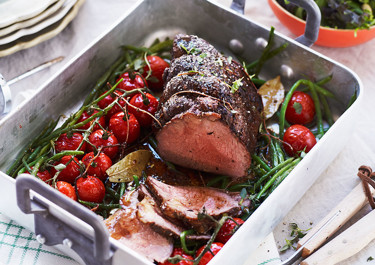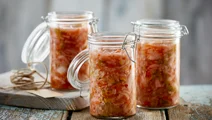Roast beef
&format=webp)
Low-temperature roast beef is extra juicy. This recipe is not only easy to make but a delicious classic. Including vine tomatoes that are baked together with the meat and get extra colour in the oven while the meat rests, you will be surprised by this delicious combination. In this recipe we pair it with a green bean side that you will love.
Ingredients
Roast beef
|
600 g
Roast beef or flank steak
|
|
|---|---|
|
Butter and rapeseed oil
|
|
|
1 tsp
Salt
|
|
|
1 tsp
Black pepper
|
|
|
1 tbsp
Chopped fresh thyme
|
|
|
300 g
Cherry tomatoes on the vine
|
|
|
3
Bay leaves
|
|
|
Flake salt
|
Green beans with garlic
|
200 g
Fresh green beans
|
|
|---|---|
|
3 tbsp
Butter and rapeseed oil
|
|
|
1
Pressed garlic clove
|
|
|
Black pepper to taste
|
Instructions
Step 1
Step 2
Step 3
Step 4
Step 5
Step 6
Step 7
Questions about roast beef
Read below the most frequently asked questions about roast beef.
How do I cook a beef roast without drying it out?
There are three tricks to prevent your roast from drying out. Step one is to sear your meat before roasting to lock in those succulent juices right from the start. Next, always use a meat thermometer as a fail-proof way of knowing when your meat is done and avoiding overcooking. And lastly, let your roast rest for at least 10-15 minutes before serving.
Should roast beef be cooked covered or uncovered?
Roast beef should always be cooked uncovered to achieve that slightly charred outer layer and succulently tender meat.
What herbs and spices go well with beef?
While salt, pepper, thyme and a few bay leaves are a basic mix, it’s one of our favourites for roast beef. If you want to mix it up some more, add hearty herbs like rosemary, oregano, and tarragon or spices like cumin, paprika or cayenne pepper for an extra kick.
What happens if you don't brown meat before slow cooking?
Browning, or searing, the meat will seal in its juices. This sets you up for roast beef perfection where every drop of moisture is preserved right from the start. Skipping this step will also mean you lose out on that beautiful caramelisation, an essential flavour that often differentiates a good roast from an excellent one.
How long should you roast beef for?
This depends on the weight and how you like to eat your meat. A general rule of thumb for a rare roast is 15-20 minutes per 500 g. For medium rare, increase the cooking time to 20-25 minutes and for well-done, 25-30 minutes per 500 g. The most reliable way is to check the internal temperature with a meat thermometer (60°C for rare, 65°C for medium, or 70°C for well-done).
What cut of beef is used for roast beef?
There isn’t one specific cut that is used for roast beef. Great options include ribeye (bone-in if possible), topside, silverside, or sirloin.
A melt-in-your-mouth roast
This recipe will invoke many a childhood memory of the family gathering for a weekend lunch. Roasted low and slow and served with crunchy green beans, this succulent beef and vegetable combo is what lazy Sundays are all about.
Low temperature roast beef secrets
The melt-in-your-mouth tenderness of this roast is all thanks to a low and slow cooking process. Scientifically speaking, it softens the tough connective tissues and keeps the meat at its succulent best. Our top three tips are: sear (or brown) the meat before roasting, use a meat thermometer to get the perfect doneness every time, and rest your meat for at least 10-15 minutes before serving.
Sauces that pair well with roast beef
Making a gravy from the leftover cooking juices is the most obvious and traditional pairing. Create a cornflour slurry (two tablespoons of cornflour mixed with two tablespoons of water), add extra liquid if needed (water or beef stock) and thicken over low heat. Other great flavour combinations include a tangy mustard sauce, peppery horseradish, or a fruity chutney for a sweeter alternative.
Serving suggestions and what to make from any leftovers
Potatoes in any shape or form – from roasted and mashed to creamy gratins and tangy salads – will pair well. Rich and savoury Yorkshire puddings are also a great side, especially when combined with a thick gravy. You can also serve it with a fresh garden salad, caramelised brussels sprouts, or roasted vegetables. For leftovers, it won’t get much better than a roast beef sandwich on rye.








